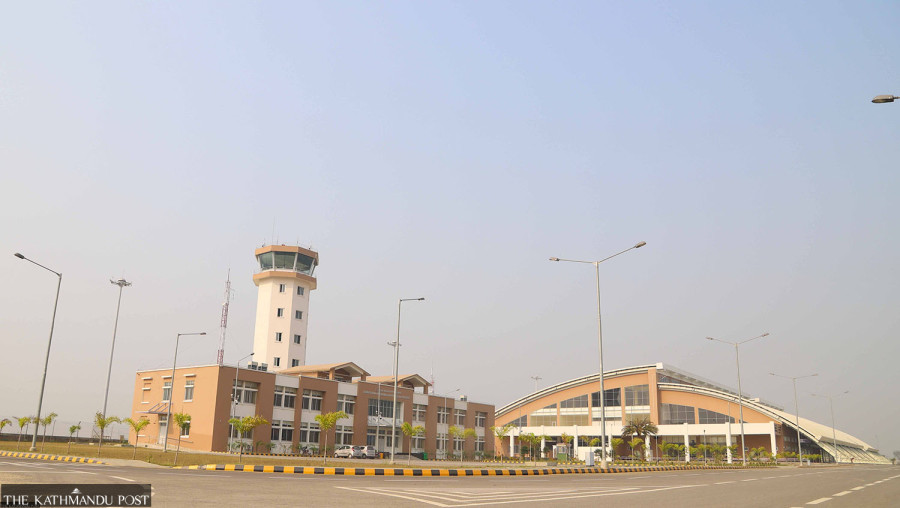Money
High costs of fuel and ground handling keeping airlines away
The government spent nearly Rs40 billion to build Bhairahawa airport, and it has been trying hard to get foreign airlines to use it.
Sangam Prasain
The government has announced a host of free services for a year to attract foreign airlines to newly opened Gautam Buddha International Airport in Bhairahawa, but insiders say the high costs of fuel and ground handling will keep them away.
Carriers will not have to pay for landing, parking, communication, navigation or security services, according to Deo Chandra Lal Karna, spokesperson for the Civil Aviation Authority of Nepal. “This means foreign airlines will be getting services worth around $2,000 free of cost per flight.”
A minister-level decision approved the scheme on May 17 to come into effect from May 28.
The government spent nearly Rs40 billion to build the country's second international airport in the southern plains, and it has been trying hard to get foreign airlines to use the new facility since it launched on May 16.
But civil aviation officials say the free services are unlikely to entice foreign airlines to stop at Gautam Buddha International Airport because Nepal's fuel costs and ground handling charges are very high.
“Airlines will think twice before making their plans,” they said. “The free scheme announced by the Civil Aviation Authority of Nepal is like giving airlines a Rs1,000 discount and collecting Rs100,000 in other charges,” the officials said.
“Airlines are not much concerned about the fees collected by the authority; the ground handling charges and cost of fuel matter more to them.”
Fuel prices in Nepal are extraordinarily high because Nepal Oil Corporation has a cross-subsidy policy.
“The ground handling charges, which are collected by Nepal Airlines, are among the most expensive in the world because it has a monopoly,” the officials said.
“International airlines frequently discuss these two costs. This is also preventing new airlines from entering Nepal because they are very high.”
Airline officials say they have been cheered by the recently unveiled policies and programmes of the government for fiscal 2022-23 which said an auto fuel pricing mechanism would be implemented from the next fiscal year beginning mid-July.
Gautam Buddha International Airport is a 280-km drive from Kathmandu, and it is also intended to serve as an alternate and backup international air transport point for Nepal, should poor weather conditions or a natural calamity shut down the capital's Tribhuvan International Airport.
Located in south central Nepal and spread over 533 hectares, the new airport is an infrastructure showpiece, according to tourism industry insiders.
The modern facility has a 15,169 square-metre terminal building with a capacity to serve nearly a million passengers a year. The airport's 3,000-metre runway is long enough to handle the largest commercial jets.
Kuwait-based Jazeera Airways made the first international flight to the new airport on May 16. The carrier operates three weekly flights on the Bhairahawa-Kuwait City route—on Mondays, Wednesdays and Fridays.
Nepal Airlines formally submitted a letter of intent on Wednesday to link Gautam Buddha International Airport with the Indian capital New Delhi and other cities in India, according to the Civil Aviation Authority of Nepal.
“No other airline has applied to serve Bhairahawa so far.”
Airlines representatives and travel trade entrepreneurs say the airport took many years to complete, but the government lacks the vision to properly market it.
According to airline officials, starting a new route can be expensive for any carrier, especially if they are flying to a new airport for the first time. Many new airports provide subsidies to attract airlines, especially if they are previously unserved cities, they say.
“If you build a new airport, you simply need to make it affordable,” Birendra Basnet, managing director of Buddha Air, Nepal’s largest private carrier, told the Post in a recent interview.
“Airlines do not expect subsidies for long periods. But it helps, particularly in the initial airport setup, to encourage airlines to launch services because the subsidy can lower the risk of their entry.”
The civil aviation body has claimed that several other international airlines have expressed interest to serve the new airport. But they are yet to apply.
“The government’s announcement of fully waiving landing, parking, communication, navigation and security charges is a scheme related to airlines. The government needs to come up with offers to attract tourists to Lumbini as well,” said a representative of the international airline who spoke on condition of anonymity.
“The government should provide discounts on passenger service charges too in order to make the ticket prices cheaper to attract passengers,” he said. “Low airfares create demand.”
The government should promote the new airport and tell travellers and airlines about Lumbini, the birthplace of Buddha, according to tourism entrepreneurs.
Plans to begin promotional activities and marketing for the new airport were made several times, but they all came to nothing. Delays in project completion and frequent changes in government led to the plans being abandoned.
In January 2020, before the Covid-19 pandemic started, the Tourism Ministry had sent a proposal to the Finance Ministry suggesting an exemption of landing and parking fees for airlines for a certain period.
“It took nearly two and a half years for the government to announce the scheme,” said a tourism entrepreneur. “This is how the government is promoting the new airport and tourism.”




 7.12°C Kathmandu
7.12°C Kathmandu













%20(1).jpg&w=300&height=200)
